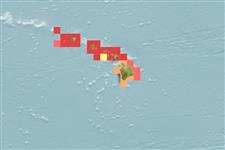>
Perciformes/Uranoscopoidei (Sand dwellers) >
Ammodytidae (Sand lances)
Etymology: Ammodytoides: Greek, ammos = sand + Greek, dytes = anyone that likes immersions, diving (Ref. 45335); pylei: Named for Richard Pyle.
Eponymy: Dr Richard Lawrence Pyle (d: 1967) is an ichthyologist and marine biologist at Bishop Museum, Honolulu, which he joined as an Ichthyology Collections Technician (1986). [...] (Ref. 128868), visit book page.
More on authors: Randall, Ida & Earle.
Environment: milieu / climate zone / depth range / distribution range
पारिस्थितिकी
समुद्री बेनथोपिलाजिक; गहराई सीमा 7 - 120 m (Ref. 10672). Tropical; 24°N - 18°N, 161°W - 151°W (Ref. 57359)
Eastern Central Pacific: Molakai to the Ladd Seamount, Hawaii.
आकार / वज़न / Age
Maturity: Lm ? range ? - ? cm
Max length : 17.3 cm SL पुल्लिंग / अलिंग; (Ref. 10672); 14.2 cm SL (female)
Loose aggregation feeds on zooplankton as much as 5 meters above the sandy bottom. Highly protrusible premaxilla facilitates feeding on small animals of the zooplankton (Ref. 10672).
Life cycle and mating behavior
परिपक्व अवधि | पुनरुत्पत्ति | मछलीऔ का अंडे देना | अंडे | Fecundity | लार्वा
Randall, J.E., H. Ida and J.L. Earle, 1994. Ammodytoides pylei, a new species of sand lance (Ammodytidae) from the Hawaiian Islands. Pac. Sci. 48(1):80-89. (Ref. 10672)
IUCN Red List Status (Ref. 130435: Version 2024-1)
Threat to humans
Harmless
Human uses
मात्स्यिकी: निर्वाह मात्स्यिकी
साधन
Special reports
Download XML
इंटरनेट स्रोत
Estimates based on models
Preferred temperature (Ref.
123201): 15.6 - 25, mean 20.3 °C (based on 2 cells).
Phylogenetic diversity index (Ref.
82804): PD
50 = 0.5010 [Uniqueness, from 0.5 = low to 2.0 = high].
Bayesian length-weight: a=0.00324 (0.00140 - 0.00746), b=3.07 (2.88 - 3.26), in cm total length, based on LWR estimates for this (Sub)family-body shape (Ref.
93245).
Trophic level (Ref.
69278): 3.4 ±0.45 se; based on food items.
लौटाव (Ref.
120179): माध्यम, न्यूनतम जनसंख्या दुगनी होने का समय 1.4 - 4.4 वर्ष। (Preliminary K or Fecundity.).
Fishing Vulnerability (Ref.
59153): Low vulnerability (11 of 100).
